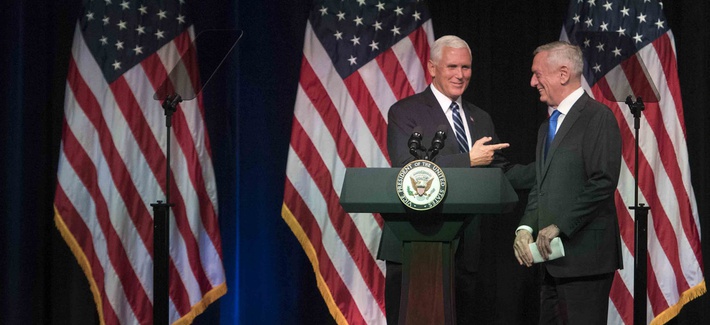Is It Time for a Space Force?
Editor’s Note: One of President Trump's more surprising, and more ambitious, decisions is to create a sixth branch of the military dedicated to space. Such a move would be historic, but would it be a good idea? Robert Farley of the University of Kentucky weighs the pros and cons and ends up on the skeptical side, arguing that there are better approaches to securing the U.S. ability to operate and dominate in space.
Daniel Byman
***

Published by The Lawfare Institute
in Cooperation With

Editor’s Note: One of President Trump's more surprising, and more ambitious, decisions is to create a sixth branch of the military dedicated to space. Such a move would be historic, but would it be a good idea? Robert Farley of the University of Kentucky weighs the pros and cons and ends up on the skeptical side, arguing that there are better approaches to securing the U.S. ability to operate and dominate in space.
Daniel Byman
***
Are we on our way to a United States Space Force? On June 19, President Trump announced that he would direct the Department of Defense to establish a dedicated Space Force, “separate but equal” from the Air Force and presumably the other existing services. On August 9, Vice President Pence reaffirmed the administration’s commitment, and laid out some details on the development of the new service. Of course, the president cannot merely create a Space Force. Reorganizing the Department of Defense would require an act of Congress on par with the National Security Act of 1947 (which created DoD and the USAF), or of the Goldwater-Nichols Act of 1986. However, the presidential directive does make it more difficult for the Pentagon and the existing services to publicly oppose the creation of a Space Force. In 2017, the House Armed Services Committee considered a bill that would create a Space Corps, a level of independence somewhat below that of an independent service. The proposal went nowhere beyond demonstrating congressional interest in the military aspects of space, as it inspired resistance from the Air Force and from the Pentagon. The combination of presidential and congressional interest in creating a new military organization for space does suggest that the idea has some legs, even if the bureaucracy attempts to impose significant roadblocks.
The Reasons Why
The idea of a Space Force has bounced around the bureaucracy and the think tank archipelago for some time, but had not gained serious currency until President Trump began exploring the idea rhetorically. The United States has not created a new service since the 1940s, when the birth of the U.S. Air Force shook the entire defense establishment. Yet this is not the first proposal to redesign the service architecture; previous proposals (made more and less seriously) have involved independent services for submarines, Special Operations Forces, cyber forces, and counter-insurgency-specialized ground forces. In many cases, these proposals resulted in levels of autonomy below an independent, co-equal service.
So why one and not the other? Why should some military capabilities belong within established services, and others require a new organization? The creation of a new service is essentially a political act, intended to force the uniformed military to adopt a preferred structure. It has little to do with a specific geographic domain; every U.S. service operates in space, just as all have continued to operate in the air despite the creation of the USAF. Political interest in the preferred structure may come from a desire to protect particular capabilities from broader organizational processes. For example, early aviators called for an independent air force in order to enable the creation of modern air doctrine and modern aircraft free of the demands of “ground pounders” in the Army. A similar call emerged in the 1980s, as the Special Operations Forces community, frustrated with a lack of support from the existing services, called for the creation of an independent service. Proponents of the Space Force argue that space assets currently compete for priority within the Air Force, and that the Air Force devotes insufficient resources and attention to the space warfare.
Another reason is to achieve gains from specialization through the commitment of resources and personnel to a specific domain or weapon system. Big organizations can lose cultural cohesion, and consequently focus on a particular kind of warfighting. By creating a new service, civilian leaders can reintroduce cultural and bureaucratic logics that reinforce the pursuit of excellence in a domain of family of systems. This logic is often related to the idea of mission coherence, which suggests that service boundaries should be formed around discrete, coherent mission planning-can this organization plan and achieve victory better when it is independent of other organizations, or at least in arms-length relation to other organizations? This is the logic that undergirded USAF independence in 1947, creating an unfettered organization to plan for and win wars with strategic bombing campaigns. Freed from the burden of facilitating air, naval, and army operations, Space Force would focus its attention on offensive and defensive satellite warfare, independently developing doctrine to provide for the dominance of space, protecting the satellites that form the backbone of U.S. communications and intelligence networks, and threatening those of Russia and China.
More generally, some scholars have argued that more services means more competition, which pays dividends in both effectiveness and procurement. The Air Force, for example, learned much from the outstanding performance of Navy pilots during the Vietnam War. Competition over ballistic missiles between the three services in the 1950s probably propelled those systems into rapid development.
Better Together?
But there are downsides to an independent service. The development of an independent service (separate but equal) creates a bureaucratic wall that runs through mission planning and execution, and can distort procurement. The 1947 reorganization yielded the USAF, which then led to bitter inter-service conflict that affected operations in Korea, Vietnam, Grenada, and perhaps most disastrously in Operation Eagle Claw, the failed effort to rescue hostages from the U.S. Embassy in Tehran. Goldwater-Nichols smoothed those edges somewhat, as has the experience of continuous war over the past seventeen years.
Conflicts are likely to become particularly acute for a service whose responsibilities cut across so many different missions. Inter-service conflict can be manageable at a mission level when the responsibilities of each service are internally coherent, and collaboration amounts to an arm’s-length transaction. While the Army and the Navy had conflicts prior to World War II, for example, these conflicts rarely involved disruption to core missions because the missions of each service were largely distinct from one another, except in unusual and manageable cases.
The development of manned flight, on the other hand, meant that every service required management of the air domain at all times; creating an independent service to manage air made conflict inevitable. It is no accident that many of the worst inter-service conflicts in the United States have revolved around the provision of close air support. Close air support (the use of airpower to attack ground forces in close proximity to friendly units) necessarily requires collaboration between ground and air units, but is valued differently by the Army and the Air Force. This conflict has played out in the real-time provision of combat capability, but also in procurement, as we enter the fifth decade of the saga of the Air Force’s effort to kill off the A-10 Warthog.
This makes the idea of a Space Force look particularly troubling. Every mission that the U.S. military conducts involves space in some fashion. Every service depends on connectivity provided by communications satellites and reconnaissance data provided by surveillance satellites. Other manifestations of space-related military power, such as ballistic missile defense, also cross existing service lines. The potential for competition is ripe, with the lines of conflict glaring and obvious; the priorities of the other services in space will necessarily conflict with the priorities of the Space Force itself. Bureaucratic walls can create unexpected problems as means of communications, jargon, and professional expectations differ across organizations; in the past, simple definitional misunderstandings between services have produced serious problems. As it develops its own identity and organizational culture, a Space Force may struggle to provide the level of service that the other organizations have grown to rely on.
Conclusion
There are substantial downsides and few clear upsides to the creation of an independent space force. A Space Force could capture some gains to specialization reflected in the development of offensive and defensive weapons designed to protect U.S. space-based assets, or threaten the space-based assets of potential foes. The creation of a Space Force could also ensure that space receives sufficient bureaucratic attention, and that it does not need to compete within an organization against other priorities.
But it is not obvious that the existing services have allowed space to lay fallow, or that there are substantial unexplored gains in the area of offensive or defensive space weaponry. Other solutions, including the creation of a combatant command dedicated to space (which would include personnel and priorities from the existing services, rather than residing in the Air Force), or the creation of a Space Corps within the Air Force (similar organizationally to the U.S. Marine Corps) could potentially resolve the problems that a Space Force is supposed to solve, without creating a complex new bureaucratic hierarchy. To this point, the Trump administration has not offered a compelling logic for why the problem of fighting in space requires such a drastic organizational solution.





